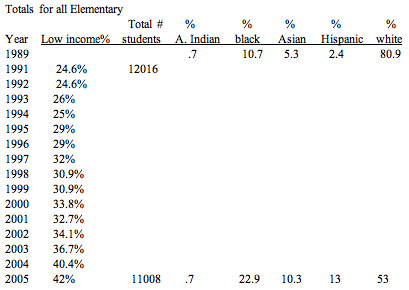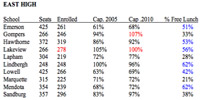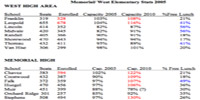This is Not Your Grandchild's Madison School District
While viewing the MMSD web site I came across some data called District data profile that suprised me, and answered some of my questions concerning low income disparity. While sitting on the task force, I have been bothered by the districts solution for dealing with high numbers of low income students by rearranging school boundaries and/or paring schools, and wondered if you really solved the disparity issue or if you shifted the issue to another school or something that would have to be solved at another time.
Madison school district low income percentages per www.mmsd.org 1991 - 2005.
 |
 |  |
| East High 2005 - 2010 Elementary Projections (click to view a larger version) | Memorial/West 2005 - 2010 Elementary Projections (click to view a larger version) |
In 13 years, 1992 to 2005, MMSD low income percentage has gone from 24.6% to 42%.
- Has the definition of low income changed during this time period?
- Has the community as a whole really changed this much in 13 years?
As a community member that hears and believes there is no low income housing, where do these people live if 42% of our community is now low income?
- We have lost 1000 elementary students in the same time period and doubled our minority students. Is this a wave of low births or are we losing students?
Middle School totals- In 1991 there were 4776 students with a 20.3% low income.
- In 2005 there are 5297 students with a 38.6% low income.
High School totals- In 1991 there were 6435 students with a 12% low income.
- In 2005 there are 8429 students with a 28% low income.
The question about
pairing two schools and whether it improves low income percentage numbers over time was also in the data.
- Lincoln in 1991 was at 51% low income, 1997 59%, and 2005 69%.
- Midvale in 1991 was 42% low income, and 2005 it is at 64%.
It does not seem to have improved the high percentage of low income numbers.
Posted by Mary Battaglia at December 2, 2005 6:36 AM
Subscribe to this site via RSS/Atom:  Newsletter signup | Send us your ideas
Newsletter signup | Send us your ideas


 | Newsletter signup | Send us your ideas
| Newsletter signup | Send us your ideas Newsletter signup | Send us your ideas
Newsletter signup | Send us your ideas